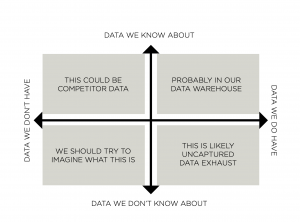The Importance of Data Strategy
Organizations have been trying to harness data for the best part of thirty years – since the widespread use of computers. Companies like Google and Amazon owe their market dominance to their smart use of data. Today affordable storage and processing power allows any organization to put its data to good use. We now have the power to make small ongoing improvements or to transform industries. In either case, we should be thinking about developing a data strategy.
Why bother with Data Strategy?
Of course it’s not critical today and revenues will continue to come in and even grow with out it. However, it is important to plot a course for the future, even if that future is one major product release away.
What is Data Strategy?
Data Strategy is a strategic plan to consider data as a corporate asset. It will provide sustainable competitive advantage in the future and that will have a rate of return when investment is made. As per the definition of a strategic asset, without such an asset, the future well-being of the organization could be in jeopardy.
What happens without a strategic view of data?
Opportunities missed, especially in today’s business environment: your current competitors will be leveraging their data; your vendors will be looking to move into your value chain; and startups will build new value propositions based on data. You might find yourself unpleasantly surprised as a worst case (the taxi industry with Uber, the hotel industry with AirBnB), but as a pretty average case, when data is an afterthought, it delays the launch of new insights, features, and products.
Where is your data?
The stuff that’s in your databases… yeah, you know about that. But what about all the other data? The most interesting new products come from data you never knew you had.

Three outcomes of a good Data Strategy?
- You will anticipate data inspired and driven products. Products you can build internally or that you may find your competitors are already building
- You will ensure that new systems are plumbed for data, that acquisition, pipelines, storage and analytic tools are already in place
- Will will be collecting the data you will need and in the right format and granularity with the right attributes, far an advance of when you actually need 12 months’ history to work on them
Where to start?
The good news is that you can start from here! In fact you would probably have to, it is unlikely that you would not have legacy systems. Take an inventory of the buckets of data available, systems and key transaction tables and reference tables. Then examine how that data is being utilized to make decisions. Is the data being used to its full potential? Ask if decisions are being made wanting of more data? Are people craving data to improve internal process or present customers with more insight? Can you envisage whole new products and services driven by data? Ideally you would follow a methodical process to work through from legacy to future vision, and then you would map out the strategy for data acquisition, storage, analysis and product development.
When is the best time to begin?
When you are putting in a new system or suite of systems, undertaking some sort of digital transformation or setting the technology plan to absorb a newly acquired business. These are normally pivotal times to create action and deliver a stream of results quickly.
(There is also a Data Strategy slideshare available for download)

